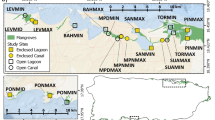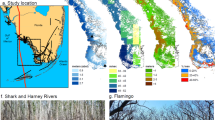Abstract
The effects of reduced tidal flushing on post-hurricane mangrove recovery were measured across a gradient of hurricane disturbance (in order of decreasing wind intensity: Captiva, North Sanibel, Central Sanibel, and East Sanibel). Each region consisted of replicate study plots with either reduced tidal exchange (tidally restricted location) or an open tidal connection (tidally unrestricted location). Locations with reduced tidal exchange displayed significantly lower (two-way ANOVA, p ≤ 0.0001) tidal amplitude, decreased seedling densities, and decreased productivity (recruitment, growth, and litter fall) when compared to the tidally unrestricted locations. Results also indicated significant regional variations in measures of mangrove stand structure (seedlings and canopy) and productivity (recruitment, growth, and litter fall) up to 4-years post-hurricane disturbance. These findings suggest that the legacy effects from hurricane disturbance vary with degree of wind intensity, acting both independently and synergistically with the effects of tidal restriction to influence post-hurricane mangrove structure and function.



Similar content being viewed by others
References
Ball, M.C., M.J. Cochrane, and H.M. Rawson. 1997. Growth and water use of the mangroves Rhizophora apiculata and R. stylosa in response to salinity and humidity under ambient and elevated concentrations of atmospheric CO2. Plant, Cell and Environment 20: 1158–1166.
Baldwin, A., M. Egnotovich, M. Ford, and W. Platt. 2001. Regeneration in fringe mangrove forests damaged by Hurricane Andrew. Plant Ecology 157: 149–162.
Boose, E.R., D.R. Foster, and M. Fluet. 1994. Hurricane impacts to tropical and temperate forest landscapes. Ecological Monographs 64: 369–400.
Bouchard, V., D. Gillon, R. Joffre, and J. Lefeuvre. 2003. Actual litter decomposition rates in salt marshes measured using near-infrared reflectance spectroscopy. Journal of Experimental Marine Biology and Ecology 290: 149–163.
Boumans, R.M.J., D.M. Burdick, and M. Dionne. 2002. Modeling habitat change in salt marshes after tidal restoration. Restoration Ecology 10: 543–555.
Carter, M.R., L.A. Burns, T.R. Cavinder, K.R. Dugger, P.C. Fore, D.B. Hicks, H.L. Revells, and T.W. Schmidt. 1973. Ecosystem analysis of Big Cypress swamp and estuaries. U.S. Environmental Protection Agency Report 904/9-74-002 Atlanta, GA.
Chen, R., and R.R. Twilley. 1998. A gap dynamic model of mangrove forest development along gradients of soil salinity and nutrient resources. The Journal of Ecology 86: 37–51.
Clark, J. 1976. The Sanibel Report: formulation of a comprehensive plan based on natural systems. Washington, D.C.: The Conservation Foundation.
Corbett, C.A. 2006. Seagrass coverage changes in Charlotte Harbor, Florida. Florida Scientist 69: 7–23.
Day, J.W., C. Coronado-Molina, F.R. Vera-Herrera, R. Twilley, V.H. Rivera-Monroy, H. Alvarez-Guillen, R. Day, and W. Conner. 1996. A 7 year record of above-ground net primary production in a southeastern Mexican mangrove forest. Aquatic Botany 55: 39–60.
Doyle, T.W., T.J. Smith, and M.B. Robblee. 1995. Wind damage effects of Hurricane Andrew on mangrove communities along the southwest coast of Florida, USA. Journal of Coastal Research 21: 159–168.
Duke, N.C., M.C. Ball, and J.C. Ellison. 1998. Factors influencing biodiversity and distributional gradients in mangroves. Global Ecology and Biogeography Letters 7: 27–47.
Ellison, A.M., and E.J. Farnsworth. 1996. Anthropogenic disturbance of Caribbean mangrove ecosystems: past impacts, present trends, and future predictions. Biotropica 28: 549–565.
Ellison, A.M., and Simmons. 2003. Structure and productivity of inland mangrove stands at Lake MacLeod, Western Australia. Journal of the Royal Society of Western Australia 86: 25–30.
Everham, E.M., and N.L. Brokaw. 1996. Forest damage and recovery from catastrophic wind. The Botanical Review 6: 114–149.
Granek, E.F., and B.I. Ruttenberg. 2007. Protective capacity of mangroves during tropical storms: a case study from Wilma and Gama in Belize. Marine Ecology Progress Series 343: 101–105.
Hughes, C.E., P. Binning, and G.R. Willgoose. 1998. Characterization of the hydrology of an estuarine wetland. Journal of Hydrology 211: 34–49.
Imbert, D., P. Labbe, and A. Rousteau. 1996. Hurricane damage and forest structure in Guadeloupe, French West Indies. Journal of Tropical Ecology 12: 663–680.
Kathiresan, K., and B.L. Bingham. 2001. Biology of mangroves and mangrove ecosystems. Advances in Marine Biology 40: 81–251.
Lemmon, P.E. 1956. A spherical densitometer for estimating forest overstory density. Forest Science 2: 314–320.
Lugo, A.E. 1980. Mangrove ecosystems: sucessional or steady state? Biotropica, supplement: Tropical Succession 12: 65–82.
Lugo, A.E. 2000. Effects and outcomes of Caribbean hurricanes in a climate change scenario. The Science of the Total Environment 262: 243–251.
Lugo, A.E., and F.N. Scatena. 1996. Background and catastrophic tree mortality in tropical moist, wet, and rain forests. Biotropica 28: 585–599.
Lugo, A.E., and S.C. Snedaker. 1974. The ecology of mangroves. Annual Review of Ecology and Systematics 5: 39–64.
Mfilinge, P.L., N. Atta, and M. Tsuchiya. 2002. Nutrient dynamics and leaf litter decomposition in a subtropical mangrove forest at Oura Bay, Okinawa, Japan. Trees 16: 172–180.
Milbrandt, E.C., and M.N. Tinsley. 2006. The role of salt wort (Batis maritima L.) in regeneration of degraded mangrove forests. Hydrobiologia 568: 369–377.
Milbrandt, E.C., J.M. Greenawalt-Boswell, P.D. Sokoloff, and S.A. Bortone. 2006. Impact and response of Southwest Florida mangroves to the 2004 Hurricane Season. Estuaries and Coasts 29: 979–984.
Meyers, J.M., C.A. Langtimm, T.J. Smith III, and K. Pednault-Willett. 2006. Wildlife and habitat damage assessment from Hurricane Charley: recommendations for recovery of the J. N. “Ding” Darling National Wildlife Refuge Complex. U.S. Geological Survey Open File Report 2006-1126. http://sofia.usgs.gov/publications/ofr/2006-1126/index.html Accessed 09 Dec 2009.
NOAA. 2009. Tides & currents. Tarpon Bay, Fl: Station Information. Station ID 8725362. http://www.tidesandcurrents.noaa.gov Accessed on 09 Dec 2009.
Proffitt, C.E., E.C. Milbrandt, and S.E. Travis. 2006. Red mangrove (Rhizophora mangle) reproduction and seedling colonization after Hurricane Charley: comparisons of Charlotte Harbor and Tampa Bay. Estuaries and Coasts 29: 972–978.
Putz, F.E., and H.T. Chan. 1986. Tree growth, dynamics, and productivity in a mature mangrove forest in Malaysia. Forest Ecology and Management 17: 211–230.
Ridd, P., R. Sam, S. Hollins, and G. Brunskill. 1997. Water, salt and nutrient fluxes of tropical tidal saltflats. Mangroves and Salt Marshes 1: 229–238.
Ross, M.S., P.L. Ruiz, J.P. Sah, D.L. Reed, J. Walters, and J.F. Meeder. 2006. Early post-hurricane stand development in fringe mangrove forests of contrasting productivity. Plant Ecology 185: 283–297.
Sadd, S., M.D. Hausain, R. Yaacob, and T. Asano. 1999. Sediment accretion and variability of sedimentological characteristics of a tropical estuarine mangrove: Kemaman, Terengganu, Malaysia. Mangroves and Salt Marshes 3: 51–58.
Sherman, R.E., T.J. Fahey, and J.T. Battles. 2000. Small-scale disturbance and regeneration dynamics in neotropical mangrove forests. Journal of Ecology 88: 165–178.
Twilley, R.R., A.E. Lugo, and C. Ratterson-Zucca. 1986. Litter production and turnover in basin mangrove forests in Southwest Florida. Ecology 67: 670–683.
Twilley, R.R., M. Pozo, V.H. Garcia, V.H. Rivera-Monroy, R. Zambrano, and L. Botero. 1997. Litter dynamics in riverine mangrove forests in the Guayas River estuary, Ecuador. Oecologia 111: 109–122.
Twilley, R.R., V.H. Rivera-Monroy, R. Chen, and L. Botero. 1999. Adapting to ecological mangrove model to simulate trajectories in restoration ecology. Marine Pollution Bulletin 37: 404–419.
Acknowledgements
This research was supported by funds from the Explorers Club of Southwest Florida and Florida Gulf Coast University Office of Research and Sponsored Programs. The authors wish to thank Sanibel–Captiva Conservation Foundation, J. N. Ding Darling National Wildlife Refuge, Rookery Bay National Estuarine Research Reserve, and Florida Gulf Coast University Coastal and Watershed Institute. This is contribution 0019 from the Sanibel–Captiva Conservation Foundation Marine Laboratory.
Author information
Authors and Affiliations
Corresponding author
Rights and permissions
About this article
Cite this article
Harris, R.J., Milbrandt, E.C., Everham, E.M. et al. The Effects of Reduced Tidal Flushing on Mangrove Structure and Function Across a Disturbance Gradient. Estuaries and Coasts 33, 1176–1185 (2010). https://doi.org/10.1007/s12237-010-9293-2
Received:
Revised:
Accepted:
Published:
Issue Date:
DOI: https://doi.org/10.1007/s12237-010-9293-2




